Impressions of Food and Agriculture in the Yucatan Peninsula
From March to May 2010 I traveled in Yucatan Peninsula with the intention to learn about traditional Mayan agriculture and food and what if anything was happening in terms of organic and locally based production systems.
This three month trip was entirely arranged on my own which had the benefit of flexibility, but also made things like logistical arrangements and making connections much more difficult. I did as much as I could before departing and then just took a deep breath and told myself what happens, happens. As finances were tight I stayed in the cheapest accommodation I could find- with a friend, in a hostel, in a village community center where I taught English for room and board, and in a room furnished only with a hammock.
The hammock-furnished room, along with board, was supposed to be my pay for consulting on a project proposal to restore the Mayan Milpa and create a new value chain system based on traditional agricultural production systems and food. I was extremely excited about this project and to be working in my field of expertise, but after injuring my back and confronting many administrative difficulties (including what seemed to me the simple task of getting a plastic table and chair for my room) I cut short my work in Felipe Carrillo Puerto and took a week long beach vacation to recover my health.
At the end of the week, my back not fully recovered I canceled my twenty four hour bus trip to Oaxaca to visit some organic farming projects there and spent my final weeks in Tulum trying to learn as much Spanish as possible and continue to reach out to organic growers and local food projects in the Yucatan. Despite repeated emails and phone calls I never actually met the group of organic vegetable growers based near Merida. I also did not meet with the people planning to raise USDA certified organic heritage turkeys. Nor did I get to visit the School of Ecological Farming near Mani. As all this was occurring I was very discouraged and felt I was wasting my time, but as I write this post and think about the photos that will accompany it I realize that I did learn quite a bit about food and agriculture in this area of Mexico. One day I will go back and continue to explore. For now, however, I am content to be returning to Mozambique in September 2010 to once again work with CNFA and let them make all the logical arrangements and pay for my expenses.
Vegetables and Markets
I spent my first two weeks of this trip in the small fishing village of Puerto Morelos which doesn’t really have a large regular, local market. On Wednesdays a single vendor sells a wide assortment of vegetables and fruit at an open market stand. After reading about this market and being referred to it by numerous local ex-pats I had somewhat high expectations. However, when I checked it out it seemed to me that the stand was actually a produce wholesale stand. This market seems to serve and satisfy the tourist population quite well, but I was looking for more than vegetables and fruit sold outdoors. So I crossed the highway (where I was living anyway) and purchased most of my fruit and vegetables from a shop in the Colonia. On my first trip there I was ready to buy everything, but after wandering around I wasn’t putting anything into my basket and I couldn’t quite figure out why. I was hungry, the produce was clean, and most of it was in good shape. When I picked up an iceberg lettuce and looked at the label I understood my issue. Nearly everything I was seeing was exactly what was currently available in the US in January and February. We were both getting our produce from the same Mexican sources! Eventually I purchased some zucchini, Roma tomatoes, onions, bananas, papaya and a mango. Later I discovered that early in the morning you could purchase packages of chopped vegetables (great for soup),
various washed and peeled fruits, and sliced jicama served with chile powder and peeled tangerines which immediately became a favorite snack. Here I first I learned about the small squash pictured below which I mistook for a winter squash and peeled before using in soup. Despite its dark orange flesh and solid feel it can be used more as you would a large patty pan summer squash.
In Merida I visited two different markets. The first was the main market was a crowded, crazy maze consisting mostly of vegetable re-sellers.
However, some of the woman who selling informally on the ground were likely to have grown what they are selling or at least have gatherered it from their family milpas and solars or wild sources in the countryside. Most of these women did not want to talk with me. Perhaps it was because they didn’t speak Spanish very well, or perhaps because I sounded so strange!
Re-sellers were more savvy and offered samples of mysterious fruit which I then had to buy.
The market sold a bit everything- clothes, prepared food, toys, tools, kitchen implements. I made several trips to explore this market.
The second market I visited in Merida sold only organic products and was founded by the new Slow Food Yucatan Chapter. The Slow Food movement originated in Italy in 1989. According to the Slow Food website it “is a non-profit, eco-gastronomic member-supported organization that was founded … to counteract fast food and fast life, the disappearance of local food traditions and people’s dwindling interest in the food they eat, where it comes from, how it tastes and how our food choices affect the rest of the world”.
It was very small and there were only three actual vegetable growers. One had already sold out by the time I arrived. The other sold cucumbers, onions and dills as well as home made sweet pickles.
The third vegetable grower was busy setting up and in no mood to chat. Some of the more unusual products were quail eggs and quail meat and packaged cashews brought in from Campeche where they were grown. I’m unsure if the vendors selling both these products were the growers or intermediaries.
Soaps, baked goods, and a tofu re-seller rounded out the market. The market was located fairly far from the city center, but I figured out how to take the city bus there for only six pesos. It was a busy and active market mainly patronized by ex-pats. It will be interesting to see if this market is able to grow and expand in the years to come. Given the large and expanding ex-pat population in Merida I suspect they will.
Traditional Agriculture
After my experiences with markets in Puerto Morelos and Merida I was ready to experience true local food and agriculture in the village of Senor and the area surrounding Felipe Carrillo Puerto. The Mayan milpa is based on the three crops, known as the Three Sisters in North America, corn, beans and squash.
The crops when grown together produce high yields without the use of chemical fertilizers and pesticides. The crops also provide complementary nutritional value. Other crops grown in a Yucatan Milpa include avocados, tomatoes, chiles, melons, jicama, amaranth and sweet potato. According to the Agroecology.org website “…demographic pressures and rural development policies are promoting the increased use of agrochemicals and have reduced the agricultural productivity of this system. Comparisons of genetic diversity of crops grown by communities practicing milpa versus those that have modernized agriculture with mechanization, agrochemicals and improved varieties show that traditional milpa systems conserve genetic diversity resources in situ while agricultural modernization erodes them”. The project I was supposed to be consulting with in Felipe Carrillo Puerto had recently organized a Mayan Seed Expo in order to help conserve and preserve the local genetic resources and promote traditional milpa growing system.
Wikipedia provides a quote from R. Nye’s PhD dissertation that explains that “the making of milpa is the central, most sacred act, one which binds together the family, the community, the universe…[it] forms the core institution of Indian society in Mesoamerica and its religious and social importance often appear to exceed its nutritional and economic importance.” It was clear during my stay in Senor that traditional social life was disappearing, most of the small stores carried predominantly junk food
and more than ten percent of the entire population of 3,000 was away working in the resorts along the Mayan Rivereira. This meant that the village seemed over populated by children and senior citizens.
The project that hosted me in Senor Xyaat was making an attempt to preserve traditional ways and had recently begun a small sustainable and traditional tourism project. The tour demanstations of making rope from hennequin, hammock making, embroidery and visits to a traditional healer and his herb garden, and to a story teller. The project is making plans to expand by provide over night housing and traditional meals to guests.

Making rope from the fibers. I tried to do this and despite patient instruction from Don Crenscencio was terrible at it.
My host at Xyaat, Marcos, taught me a lot about what grows in the traditional solar, and gave me many new fruits to sample.
The solar consists of the gardens that grow around a Mayan house and include a wide variety of fruits (some native others such as citrus imported), some herbs and vegetables and chickens, turkeys and pigs.
Unfortunately I also witnessed many of these traditional fruits from the solar rotting on the ground which given my time on the farm in New Hampshire where we dried, canned, and preserved everything we could made morn the loss. This was similar to my experience in Mozambique when I saw beautiful Roma tomatoes rotting in the fields and market and I could only think of the potential for producing preserved products. All these fruits were so much better tasting than the Red Delicious Apples I was given from breakfast.
My favorite food in the Yucatan
Panuchos, melon water, tortillas, sopa de lima and…SALSA!
Tortillas should have become a way of life and I would have been happy to adapt to it except that I never succeeded in eating a stack of ten to twelve tortillas in a sitting.
At the Merida market I had the opportunity to observe the machine-made process in action. These still taste much better than the packaged grocery store versions found in the US.
Handmade tortillas have an immensely superior flavor. I was told it has to due with the uneven distribution of fat and the slightly uneven cooking which results. I attempted to construct my own tortilla and I was doing great until I attempted to put it on the griddle at which point it stuck to my hand and ripped apart. The woman pictured below did not have the same problem.
At the Los Dos Cooking School in Merida I learned to make three salsas made with the juice from a sour orange (naranja agria) or Seville Orange rather than lime juice.
The sour orange juice in salsa was a complete taste revolution for me and explains why I love the salsa of the Yucatan more than any other.
X’nipek is made with the habanero, and char-roasted vegetables and packs the biggest punch. X’nipek means ‘dog’s nose” and describes perfectly how your nose gets wet (and runny) as a dog after consuming this salsa. It is so much tastier than the standard pico de gallo that we are used to in the US. The following recipe is thanks to David of Los Dos.
- 6 roma tomatoes, finely chopped and drained
- 1 small white onion, charred
- 1 habanero, charred, cap removed, and finely chopped
- 4 T. cilantro, finely chopped
- ¼ sour orange juice
- Pinch of sea salt
Chile Tamulado is the standard green salsa which when placed on the tabled you are warned “muy picante”! I always shocked the waiters when I use more than a drop and get even more dramatic protests of “muy picante” accompanied by frantic gesturing. Not too different from reactions in Mozambique when I asked for piri piri.
Blend all of the following in a blender and refrigerate until ready to use. Bring to room temperature before serving.
- 10-12 charrred green habaneros
- ¼ cup sour orange juice
- pinch of sea salt
K’uu Bi Ik is very simple to make and blends small dried chiles (chiles secos or chiles de arbol) with the stems and seeds removed, sour orange juice and sea salt to taste. It should rest at room temperature for at least fifteen minutes before being served.
The fourth new salsa for me is a very mild cream based salsa that I first ate at Eladio’s where I sat listening to music and drinking beer with my new friend Janet while being served free snacks on a Sunday afternoon in Merida. The waiter described how to make it. Crema Mexicana is simply pureed with chile x’catik (a large very light mild yellow chile), and garlic. While visiting a family in Felipe Carrillo Puerto I observed the father preparing with additions of cilantro and vegetable oil.
Impressions of food and agriculture in the Yucatan Peninsula
March-May 2010
Vegetables and Markets
I spent my first two weeks of this trip in the small fishing village of Puerto Morelos which doesn’t really have a large regular, local market. On Wednesdays a single vendor sells a wide assortment of vegetables and fruit at an open market stand. When I checked it out it seemed to me that they were not local growers, but produce wholesalers. I ended up not purchasing anything as the prices were quite high. For the most part I purchased my fruit and vegetables from a shop in the Colonia (the non sea side of Highway 307). On my first trip there I was ready to buy everything but after wandering around I wasn’t putting anything into my basket and I couldn’t quite figure out why. I was hungry, it was clean, and most of the produce was in good shape. When I picked up an iceberg lettuce and looked at the label I understood why. Nearly everything I was seeing was exactly what was currently available in the US in January and February. We were both getting our produce from the same Mexican sources! Eventually I purchased some zucchini, Roma tomatoes, onions, bananas, papaya and a mango. Later I discovered that early in the morning you could purchase packages of chopped vegetables (great for soup), various washed and peeled fruits, and sliced jicama served with chile powder and peeled tangerines.
In Merida I visited two different markets. The first was the main market was a crowded, crazy maze consisting mostly of vegetable re-sellers, but some of the woman who selling informally on the ground were likely to have grown what they are selling or at least have gatherer it from their personal milpas and solars or wild sources in the countryside. Most of these women did not want to talk with me. Perhaps it was because they didn’t speak Spanish very well, not that I did either! Re-sellers were more savvy and offered samples of mysterious fruit which I then had to buy. The market sold a bit everything- clothes, prepared food, toys, tools, kitchen implements. I spent several afternoons exploring this market.
The second market in Merida was billed as “The Slow Food Market” and only sold organic products. I was very small and there were only three actual vegetable growers. One had already sold out by the time I arrived. The other sold cucumbers, onions and dills as well as home made sweet pickles. The third grower was busy setting up and in no mood to chat. Some of the more unusual products were quail eggs and quail meat and packaged cashews brought in from Campeche where they were grown. I’m unsure if the vendors selling both these products were the growers or intermediaries. Soaps, baked goods, and a tofu re-seller rounded out the market. The market was located fairly far from the city center near Costco, but I figured out how to take the city bus there for only six pesos. It was a busy and active market mainly patronized by ex-pats. It will be interesting to see if this market is able to grow and expand in the years to come.
Traditional Agriculture
After my experiences with markets in Puerto Morelos and Merida I was ready to experience true local food and agriculture in the village of Senor and the area surrounding Felipe Carrillo Puerto.
Describe the Mayan milpa and solar.
My favorite food in the Yucatan
Panuchos, melon water, toritllas and…SALSA!
Tortillas should have become a way of life and I would have been happy to adapt to it except that I never succeeded in eating a stack of ten to twelve tortillas in a sitting.
It is so clear that handmade tortillas have a superior flavor. I was told it has to due with the uneven distribution of fat and the slightly uneven cooking which results. I attempted to construct my own tortilla and I was doing great until I actually put it on the griddle at which point it stuck to my hand and ripped apart. The woman pictured below did not have the same problem.
Photo of the tortilla machine at the Merida market.
Photo of hand made process
At the Los Dos Cooking School in Merida I learned to make three salsas made with the juice from a sour orange (naranja agria) or Seville Orange rather than lime juice. The sour orange juice in salsa was a complete taste revolution for me and explains why I love the salsa of the Yucatan more than any other.
X’nipek is made with the habanero, and char-roasted vegetables and packs the biggest punch. X’nipek means ‘dog’s nose” and describes perfectly how your nose gets wet (and runny) as a dog after consuming this salsa. It is so much tastier than the standard pico de gallo that we are used to in the US. The following recipe is thanks to David of Los Dos.
- 6 roma tomatoes, finely chopped and drained
- 1 small white onion, charred
- 1 habanero, charred, cap removed, and finely chopped
- 4 T. cilantro, finely chopped
- ¼ sour orange juice
- Pinch of sea salt
Chile Tamulado is the standard green salsa which when placed on the tabled you are warned “muy picante”! I always shock the waiters when I use more than a drop and get even more dramatic protests of “muy picante” accompanied by frantic gesturing.
Blend all of the following in a blender and refrigerate until ready to use. Bring to room temperature before serving.
- 10-12 charrred green habaneros
- ¼ cup sour orange juice
- pinch of sea salt
K’uu Bi Ik is very simple to make and blends small dried chiles (chiles secos or chiles de arbol) with the stems and seeds removed, sour orange juice and sea salt to taste. It should rest at room temperature for at least fifteen minutes before being served.
The fourth new salsa for me is a very mild cream based salsa that I ate at Eladio’s where I sat listening to music and drinking beer while being served free snacks on a Sunday afternoon in Merida. The waiter described how to make it. Crema Mexicana is simply pureed with chile x’catik (a large very light mild yellow chile), and garlic. While visiting a family in Felipe Carrillo Puerto I observed the father preparing with additions of cilantro and vegetable oil.
This three month trip was entirely arranged on my own which had the benefit of flexibility, but also made things like logistical arrangements and making connections much more difficult. As finances were tight I stayed the cheapest accommodation I could find- with a friend, in a hostel, and in a village community center where I taught English for room and board. Despite repeated emails and phone calls I never actually met the group of organic vegetable growers based near Merida. I also did not meet with the people planning to raise USDA certified organic heritage turkeys. Nor did I get to visit the School of Ecological Farming near ______________. After injuring my back in Felipe Carrillo Puerto I cancelled my trip by bus to Oaxaca to visit organic farming projects there. At the time I was very discouraged but as I write the post and think about the photos I will post to accompany it I realize that I did learn quite a bit about food and agriculture in this area of Mexico. One day I will go back and continue to explore. For know, however, I am happy to be returning to Mozambique in September 2010 and working with CNFA and letting them make all the logical arrangements and pay for my expenses.

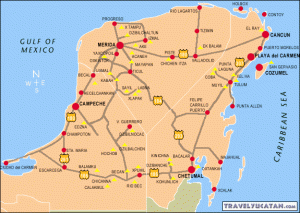
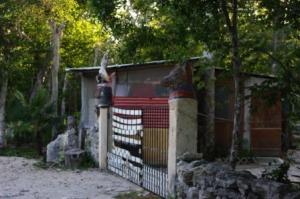




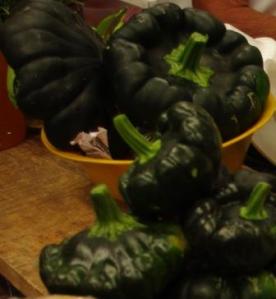



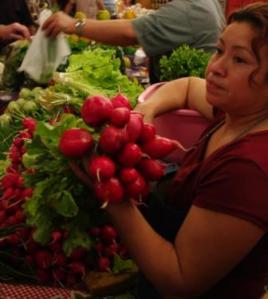
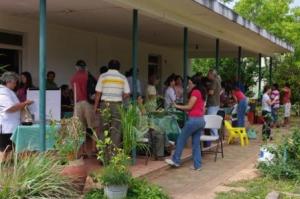
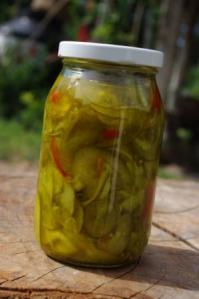





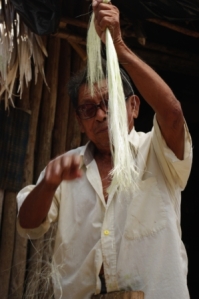
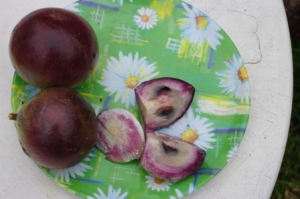
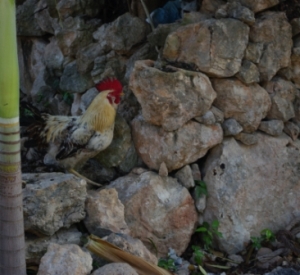


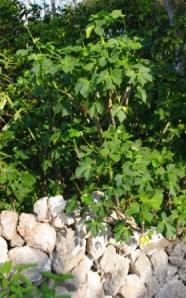
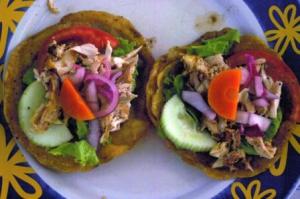



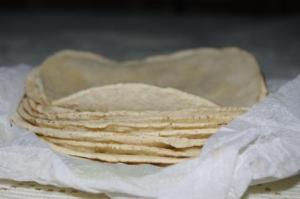
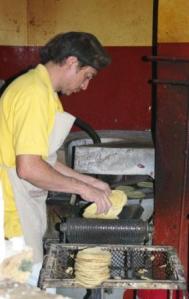



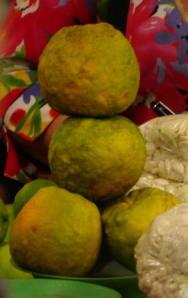

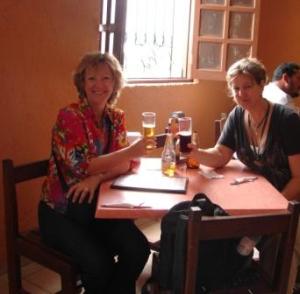

Hi there. I was very interested to come across your blog, am still reading it in fact. I just wondered if you had any tips for me, I’m going to Yucatán and Oaxaca next month to look for habanero sauce recipes, my plan is to try and get into some local kitchens and farms who produce chiles and chilli sauce, was wondering if you knew of any good places to point me in the direction of? I’ll definitely get in touch with the Slow Food people, I’m sure they would have some advice.
Well done on your blog, looks like you’ve had some great trips!
Thanks and happy new year.
Arlo
Hi Arlo.
So sorry it has taken me so long to get back to you. Life gets in the way of things some times…
Probably a little to late to send you tips. Sorry. 😦
How was your trip? Did you find any great habanero recipes? How is Slow Food Yucatán doing these days?
Kathryn